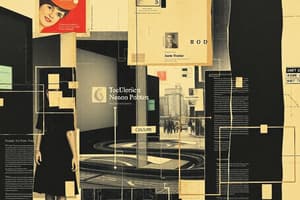Podcast
Questions and Answers
What is a computer?
What is a computer?
A programmable machine that manipulates data according to a list of instructions.
Which of the following were early computing devices? (Select all that apply)
Which of the following were early computing devices? (Select all that apply)
- Celcius Thermometer
- Abacus (correct)
- Slide Rule (correct)
- Tally Sticks (correct)
The first use of the word 'computer' referred to a mechanical device.
The first use of the word 'computer' referred to a mechanical device.
False (B)
Who is known as the first computer programmer?
Who is known as the first computer programmer?
Which device is known as the first electronic digital computing device?
Which device is known as the first electronic digital computing device?
ENIAC stands for Electronic Numerical Integrator and ______.
ENIAC stands for Electronic Numerical Integrator and ______.
What year was the first portable computer, Osborne 1, released?
What year was the first portable computer, Osborne 1, released?
What are the dates of the First Generation of computers?
What are the dates of the First Generation of computers?
Who invented the tabulating machine?
Who invented the tabulating machine?
Flashcards are hidden until you start studying
Study Notes
Definition of a Computer
- A programmable machine.
- Manages data according to instructions.
- Aids humans in computation.
- Key characteristics: responds to instructions, executes pre-recorded instructions, stores and retrieves data efficiently.
Earliest Computers
- Humans initially performed calculations, known as "computers."
- Early calculations were specialized and costly, requiring extensive mathematical training.
- The term "computer" emerged in 1613, referring to individuals performing computations.
Early Computing Devices
- Tally Sticks: Ancient memory aids for recording numbers, quantities, and messages.
- Abacus: Bead-based mechanical device for mathematical calculations. Widely used in Asia.
- Napier's Bones: Invented by John Napier in 1614. Used for multiplication, division, square roots, and cube roots through rod manipulation.
- Slide Rule: Developed by William Oughtred in 1622. Based on Napier's logarithms for calculations.
- Stepped Reckoner: Invented by Gottfried Wilhelm Leibniz in 1672. Performed addition, subtraction, multiplication, and division automatically.
- Jacquard Loom: Invented by Joseph-Marie Jacquard in 1881. Used punched cards to record data, a concept later applied to information processing.
- Arithmometer: A mechanical calculator created by Thomas de Colmar in 1820. The first reliable, commercially successful calculating machine. Performed basic arithmetic functions. The first mass-produced calculator.
- Difference Engine and Analytical Engine: Invented by Charles Babbage. The difference engine calculated polynomial functions automatically, while the analytical engine was the first mechanical computer.
Augusta Ada Byron
- Known as Ada Lovelace.
- Suggested the use of the binary system to Babbage in 1840.
- Developed programs for the Analytical Engine, considered the first computer programmer.
Scheutzian Calculation Engine
- Invented by Per Georg Scheutz in 1843.
- Based on Babbage's difference engine.
- The first printing calculator.
Tabulating Machine
- Created by Herman Hollerith in 1890.
- Aided in information summarization and accounting.
Harvard Mark 1
- Also known as IBM Automatic Sequence Controlled Calculator (ASCC).
- Developed by Howard H. Aiken in 1943.
- The first electro-mechanical computer.
Z1
- The first programmable computer.
- Developed by Konrad Zuse in Germany (1936-1938).
- Used punch tape for input and output.
Atanasoff-Berry Computer (ABC)
- The first electronic digital computing device.
- Developed by Professor John Atanasoff and student Clifford Berry at Iowa State University (1939-1942).
ENIAC
- ENIAC stands for Electronic Numerical Integrator and Computer.
- The first electronic general-purpose computer.
- Completed in 1946.
- Developed by John Presper Eckert and John W. Mauchly.
- Six female programmers were involved in its development.
EDVAC
- EDVAC stands for Electronic Discrete Variable Automatic Computer.
- The first stored-program computer.
- Designed by Von Neumann in 1952.
- Used a memory to store both programs and data.
The First Portable Computer
- Osborne 1, released in 1981 by Osborne Computer Corporation.
The First Computer Company
- Electronic Controls Company, founded in 1949 by J. Presper Eckert and John Mauchly.
Computer Generations
- First Generation (1946-1958): Primarily vacuum tubes, bulky, limited memory, slow processing.
- Second Generation (1959-1964): Transistors replaced vacuum tubes, smaller, faster, more reliable.
- Third Generation (1965-1970): Integrated circuits (ICs) enabled miniaturization, increased processing speed, improved reliability.
- Fourth Generation (1970-present): Microprocessors, personal computers, graphical user interfaces, networking revolutionized computing.
- Fifth Generation (present): Artificial intelligence, parallel processing, quantum computing, focus on user-friendly interfaces and advanced capabilities.
Studying That Suits You
Use AI to generate personalized quizzes and flashcards to suit your learning preferences.




